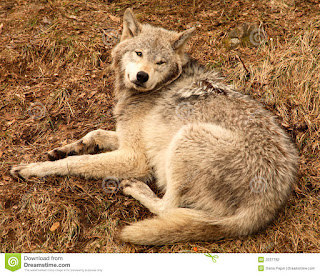Weight and size depend on the latitude . Generally it's height is about 35 cm however there are wolves that weight 77kg in Alaska and Canada.
The wildest wolf died in Alaska in 1939.
Wolves have perfect characteristics for long trips. Their chest is narrow. They are able to travel several kilometres with an average speed. Their legs are for walking with faster and with facility, especially in the snow.
Usually they are grey, brown and black and white.
They have a big snout that distinguishes shamans.
Usually they are grey, brown and black and white.
They have a big snout that distinguishes shamans.
Usually one couple of pack reproduces. is between January and April. Pregnancy lasts at least about 63 days.
RELATION WITH THE HUMANS

In most parts of the world,
the wolf is respected and revered, while in other parts it is hated.
In some situations, they act
as domestic animals, but not without difficulty, because of the problem of
socialization that they have with the dogs and their predatory instincts.
For this they need a training
and motivation, the same as dogs.
Attack to the humans
The wolves are shy and they avoid
the contact with the humans, their reaction depends on experiences with the
humans in the past, it isn’t a natural way of behaving.
There are some circumstances for
the wolves in which they can appear aggressive, for example: the provocation,
the habituation, the rage, cubs, crossing with dogs or few preys.
In simile with other carnivorous
predators, wolves don’t attack so much to humans, before, there was more risk
than now, for the presence of fury.
In fact, the usually attack for
fury.
The attacks normally happen in
summer, in June and July, the preys are normally women and children.
Wolves have been
routinely hunted for doing sport,to use their skin, to protect
the ranching and in some unusual cases to protect the
humans.
The menace for
the ranching as well as people were more than enough reasons to ally themselves
to hunt them.
Many cultures,
as the apache, hunt the wolves as a rite of passage.
They are usually diff
ALIMENTATION
Wolves feed primarily on ungulates sheep, goats, pigs, deer, reindeer, horses, moose, seals yaks whales, salmon, birds.
A wolf eats 14 kg of food a day and he doesn’t eat in 17 days.
After eating they drink plenty of water.
If there is no food they don’t eat anything.
They do not have a strategy to hunt, but when hunting large animals they try to hide.
Their bite measures 15cm.
They usually attack diseased animals to hunt and sometimes there is a surplus in the Department of Natural Resources during a spring snowstorm, two wolves killed 21 deer, consuming only two, ithappens a lot in winter.
In addition sometimes they eat plants, in Russia there are wolves attacking watermelon plantations.
INTERESTING FACTS ABOUT THE WOLVES
Their scientific name is: Canis Lupus.
In the present the wolf inhabits very few
places, as it is pursued by the man, either because of their skin, for sport, or other different
things.
In some places, like the United States
Until a few years ago,
he could be found in large regions of North America, Eurasia ,
and Middle Orient. Today, its territory has been greatly reduced.
The wolves are very territorials. The size of the territory
of a pack is around the 200 square kilometers. The pack can arrive to go over 25 kilometers for day
of their territory in search of preys.
The communication is through the howling wolves. These
serve to mark their territory against other wolves, a means of avoiding
encounters with neighbouring herds. Lone wolves do not respond to
howls.
Body language also has much to do in communicating
between the wolves. An aggressive wolf, growls, hebristles fur, and if it is bent it means
it is ready to attack.
When a wolf is angry, the ears are straight, and his
coat too, while showing teeth. If you
see their ears against the head,
it is that they are on the defensive.
The dominant wolf will remain rigid and
tall, with erect ears and forward. When hunting they maintain horizontal and
straight tail.
The wolves are carnivorous animals, predators can live
in forests, mountains, tundra, taiga and grasslands.
A wolf can eat 3.5 kilos
of food in at once, and if they are hungry, they can eat up to 15 kilos of meat a day. While they
can survive up to 15 days without eating. It has been studied that up to two
weeks, not weakness recorded in muscle activity of wolves.







